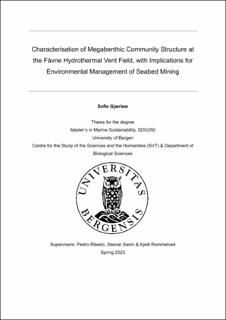Characterisation of Megabenthic Community Structure at the Fåvne Hydrothermal Vent Field, with Implications for Environmental Management of Seabed Mining
Master thesis
Permanent lenke
https://hdl.handle.net/11250/3070660Utgivelsesdato
2023-05-15Metadata
Vis full innførselSamlinger
Sammendrag
There is an increased interest for deep-sea mining in Norwegian waters due to the potential use of minerals in the green shift. However, concerns have been raised regarding the sustainability of such activities. This study contributes to the characterisation of benthic community structure at the Fåvne hydrothermal vent field located on the Arctic Mid-Ocean Ridge as a contributor to inform management and conservation policies. The research involved collecting data using remotely operated vehicles (ROVs) at a depth of approximately 3000 metres, annotating images, making a morphospecies catalogue, and performing quantitative data analysis. The results showed that the basalt had the highest species diversity and richness, whereas the inactive sulphide had the lowest. The non-metric multidimensional scaling (nMDS) plot revealed significant differences between active vents and background habitats, with individual images displaying considerable variations. There was a clear difference in species contributing to dissimilarities between habitats, particularly the amphipods sp. indet and gastropoda sp. Indet. The findings suggest that there are significant knowledge gaps that need to be addressed before any deep-sea activities can commence. A moratorium may be necessary to allow for further research on potential destructive ecological effects, as technological advances and recycling may reduce the need for minerals. Overall, this study highlights the potential impact of deep-sea mining and the need for caution and further research in this area.
Utgiver
The University of BergenOpphavsrett
Copyright the Author. All rights reservedBeslektede innførsler
Viser innførsler beslektet ved tittel, forfatter og emneord.
-
Speciation in the dark: Diversification and biogeography of the deep-sea gastropod genus Scaphander in the Atlantic Ocean
Eilertsen, Mari Heggernes; Malaquias, Manuel Antonio E. (Peer reviewed; Journal article, 2015-01-30)Aim The aim of this work was to improve understanding about the mode, geography and tempo of diversification in deep-sea organisms, using a time-calibrated molecular phylogeny of the heterobranch gastropod genus Scaphander. ... -
Demosponges from the Northern Mid-Atlantic Ridge shed more light on the diversity and biogeography of North Atlantic deep-sea sponges
Cárdenas, Paco A.; Rapp, Hans Tore (Peer reviewed; Journal article, 2015-08-06)In July–August 2004, the Mid-Atlantic Ridge Ecosystems (MAR-Eco) expedition collected Demospongiae (Porifera) from the Northern Mid-Atlantic Ridge (MAR) north of the Azores, between 41°N and 61°N. Demosponges were found ... -
A new species of the deep-sea genus Scaphander (Gastropoda, Cephalaspidea) from the Mar del Plata submarine canyon off Argentina
Siegwald, Justine; Pastorino, Guido; Oskars, Trond Roger; Malaquias, Manuel Antonio E. (Journal article; Peer reviewed, 2020)Scaphander Montfort, 1810, is a genus of deep-sea, soft-bottom gastropods composed of approximately 23 species distributed worldwide. The systematics of the genus in the Atlantic was recently revised and eight species were ...
